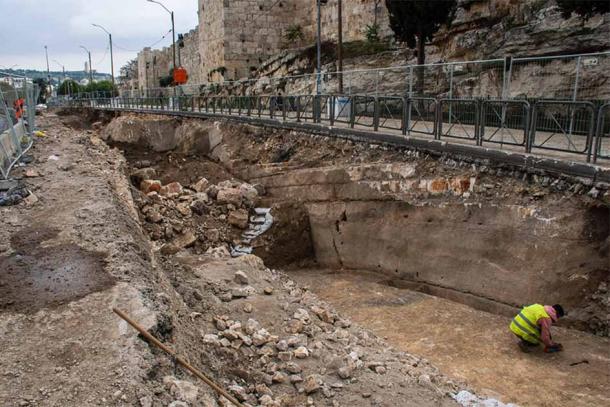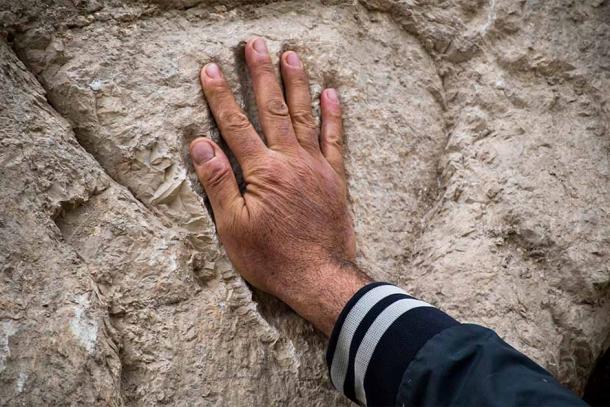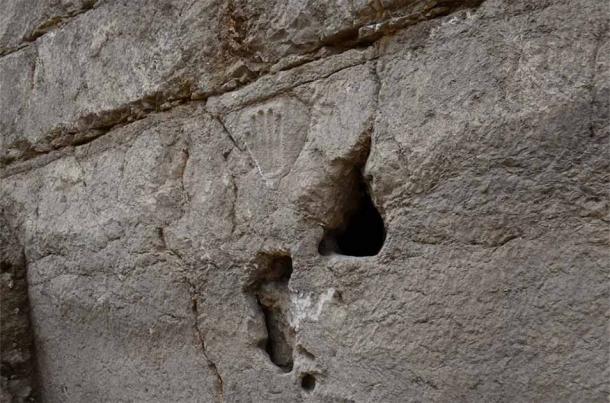A mysterious carved handprint has been discovered in Jerusalem. But, was it created by a defending Muslim, a terrified Jew, an attacking European knight, or is it just a long-forgotten local prank? Archaeologists excavating in Jerusalem discovered the mystery handprint during an infrastructure project on Sultan Suleiman Street which runs adjacent to the city’s ancient defensive walls.
The handprint was carved into a 1,000-year-old dry moat that at one time circled the entire Old City. Dating back to the 10th century, or earlier, this deep rock-hewn moat measures 10 meters (32.80 ft) deep and between 2 and 7 meters (6.65 to 22.56 ft) wide. Because the moat circled the whole of Jerusalem, its function was to prevent invaders from penetrating the city’s defensive walls. However, the purpose or meaning of the curious carved handprint is currently unknown.

A Formidable Defensive Structure Harbored the Mystery Handprint
The stone walls that protected the Old City of Jerusalem, which are still visible today, were built in the 14th century by Suleiman I the Magnificent , the Turkish Ottoman Sultan. However, it is known that Suleiman built his walls upon the foundations of much earlier fortifications that protected the ancient city’s inhabitants.
A report published in the Times of Israel explains that unlike the water-filled moats that protected European castles , the Jerusalem moat was dry. However, its sheer depth and breadth leads the researchers to describe it as a “formidable and complex” dry-moat that significantly slowed down approaching city invaders.
The dry moat surrounding old Jerusalem was so effective that in June 1099 AD attacking Crusader armies spent five weeks attempting to cross it. Adding to the European knight’s logistical problems at the doors to the City of God, Jewish and Muslim defenders hurled rocks and spilled boiling oils into the moat making the task of crossing it infinitely more dangerous.

Swords, Arrows and Charing Knights
According to the Israel Antiquities Authority ( IAA) excavation director Zubair Adawi, the moat’s function was to prevent enemies from approaching the walls and breaking into the city. The researcher told IFLScience that moats were normally filled with water, but that here in Jerusalem the moat was dry, which he said presented a formidable obstacle that slowed down the attacking army.
The researcher also said the moat was riddled with secret tunnels that enabled city defenders to rush out and attack approaching invading armies, before slipping back behind the fortifications. Dr. Amit Re’em, Jerusalem Regional Director at the IAA, said that in the eras in which knights’ battles with their “swords, arrows, and charging cavalry,” the fortifications of Jerusalem were formidable and complex, comprising walls and elements to hold off large armies storming the city.

Could the Mystery Handprint Simply Be a Prank?
While there is no argument that the mystery carved handprint is the most intriguing element discovered by the team, little can be said about it, for nobody has a clue what it represents. The archaeologists have considered that perhaps the hand was carved by either a Muslim or Jewish city defender, but it might be the case that it was crafted by an invading European knight .
But there also stands a chance that the intricately carved hand doesn’t symbolize anything, and that it was just a “local prank.” The researchers concluded that the mystery handprint , and what it meant to the artisan who left it behind, will no doubt be revealed in the future after further research on the dry moat has been completed.








